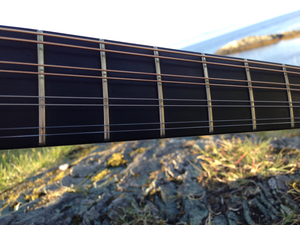Final observations
In the Prelude or Fantasia, as well as in the Fugue and the Sarabande, the problematic consequences of the necessary technical simplifications can probably be alleviated to a certain degree by employing common historically informed practice, though some basic elements such as stepwise basslines need to be altered non-idiomatically. Texture is lost, but basic melodic elements can be preserved, as I showed in the videos and sheets concerning the Fugue. When tackling the Gigue and Double, the added ingredient of traditional Scandinavian music is an enabling factor, though it keeps the final artistic outcome away from a purely Baroque aesthetic, steering it towards a personal as well as geographically influenced interpretation. If the research question to be tackled is whether Bach’s lute suite BWV 997 can be performed entirely along the guidelines of historically informed practice, the answer is no – at least for me, personally – and the main stumbling block is the technical challenge in the transition from the Gigue to the Double. If the research question opens the way for ‘other’ traditions of music to enter the equation – Scandinavian folk music, in my case – the answer is yes. As I perceive the field of artistic research, the pursuit of personal ideas (own or borrowed) is encouraged, and transformation along the way is part of the method: if my instrument prevents me from developing adequate technique to perform the music in what we think may have been its original lilt, I have to find other paths and other precedents. These paths and precedents must be close to my existing artistic identity for me to come across as convincing in performance. One might also argue that the introduction of a third element – the Scandinavian folk interpretations in addition to Baroque practice on one hand and my instrument on the other – locates the project’s intentions elsewhere than the time-honoured practice of transcriptions from one instrument to another.
Following a few months away from this music, I revisited the BWV 997 lute suite to form an impression of how accessible it would be to me without much preparation time, as stock repertoire that can be activated at short notice. Like other musicians I talk to, I find that interpretative possibilities sometimes become clearer to me when I have stayed away from focusing on technical mastery and musical details for a while.[1] Rather than submitting a full performance of the entire suite, I suggest using the Prelude as an example in attempting to answer my initial research question. Also, in my view, listeners more experienced in this music than I should be given the chance to form an opinion on the basis of an attempted performance, rather than relying solely on my word-ridden self-analysis.
Following half an hour of looking over the piece and its more challenging passages, I needed two false starts to get to the following ‘one-take’ on camera. The filmed performance leads me to the following observations:
The mistakes at 01:55, 03:01, 03:33, and 03:48, which would have been easily fixed through either editing or a full second take in a genuine recording situation, are at times direct results of the problematic horizontal movement in the left hand. There would have been less of this movement on a lute.
My flatpick angle has changed since starting work on the piece (a contribution from Strømdal, drawing on his experience from Baroque mandolin playing), so the tone is rounder than before, but speed is slightly impaired as a result. I also seem to have adopted a mandolinist’s habit, as I perceive it, of softening the attack on the top string in comparison with the other three – a useful device on the higher-pitched ‘relatives’ in this instrument family, but one that may lead to slightly Romantic-era executions, such as the accelerando at 01:40. Incorporating small non-Baroque performance tricks such as these may, however, help me execute the piece convincingly in the future, albeit in a hybrid between different schools of interpretation.
Isbin’s and Leathwood’s discussion about bass notes, quoted earlier, can be put to use again in the passage between 02:10 and 02:20, as I don’t seem capable of even reaching an approximation of the long, decisive bottom layer notes I would have preferred (and that the notation indicates). This is another limitation in the instrument.
My tendency instinctively to anticipate bass notes, which functions as a shortcut to clarity, is displayed at 02:40, and may severely impair the rhythmic, dance-rooted flow of the piece. Avoiding this may become a focus point of this movement in future at-short-notice engagements.
[1] Norwegian novelist Karl-Ove Knausgaard, in a slightly related discussion about the dynamics between method and instinct, quotes Lawrence Durrell as having said, ‘You set yourself a goal and then you go there in your sleep’. ‘Jesse Eisenberg, Kate Bush, Karl Ove Knausgaard, Our Zoo’, Front Row, BBC Radio 4, 27 August 2014 <http://www.bbc.co.uk/programmes/b04fc70k> [accessed 1 September 2014].
